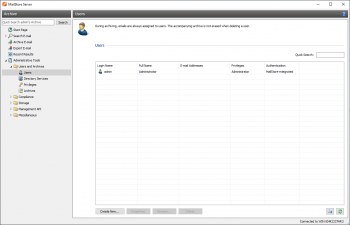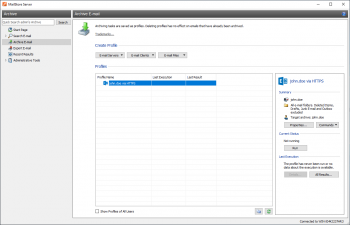Difference between revisions of "Quick Start Guide"
| [unchecked revision] | [unchecked revision] |
| Line 60: | Line 60: | ||
* Each archiving task can be executed any number of times. MailStore only archives emails which are not yet stored in the archive. By default, no emails will be deleted and no changes will be made to the mailboxes, email clients or email files (e.g. PST files) that are to be archived. | * Each archiving task can be executed any number of times. MailStore only archives emails which are not yet stored in the archive. By default, no emails will be deleted and no changes will be made to the mailboxes, email clients or email files (e.g. PST files) that are to be archived. | ||
* When archiving, emails will be indexed automatically and can be located using the integrated full-text search. By default, the contents of file attachments are not included in the search index. To be able to include the contents of certain file attachments in the search, MailStore Server has to be configured accordingly. This can be done in ''Administrative Tools'' > ''Storage'' > ''Search Indexes''. | * When archiving, emails will be indexed automatically and can be located using the integrated full-text search. By default, the contents of file attachments are not included in the search index. To be able to include the contents of certain file attachments in the search, MailStore Server has to be configured accordingly. This can be done in ''Administrative Tools'' > ''Storage'' > ''Search Indexes''. | ||
| + | |||
| + | Detailed information about archiving emails are available under [[Email Archiving with MailStore Basics]] | ||
= Setting Up User Access to the Archive = | = Setting Up User Access to the Archive = | ||
Revision as of 16:03, 21 August 2012
Starting MailStore Client
After successful installation, a new MailStore Client icon will appear on the desktop; simply double click this icon to start MailStore.
Background Information: With MailStore Client, a Windows application, users can search the archive and view archived emails. The administration of MailStore Server is also done through MailStore Client. Therefore, when installing MailStore Server, an installation of MailClient is automatically included as well.
Logging On as Administrator
When logging on as administrator, you will be prompted for the access data. Server name localhost, user name admin and password admin are preset; simply click on OK. If asked whether to trust MailStore Server, click on OK as well.
Installing a License
If MailStore Server was installed for the first time, the license manager will open after logging on as administrator. Here you can install a free 30-day trial license or an already purchased license.
Changing the Password (Recommended)
To ensure security, the administrator password should be changed after the first start of MailStore: simply click on Administrative Tools > Users and Privileges > Users. Double-click on the admin user and select Password....
Important notice: For security reasons you will not be allowed to log on to MailStore as user admin from any other computer, as long as the password is set to admin.
Adding New Users
When emails are archived, they are always assigned to individual users. For each user, whose emails are to be archived with MailStore, a corresponding user account has to be created in MailStore. As a suggestion, begin by adding a user account for yourself.
Important notice: This chapter describes how you can add a MailStore user manually. However, users can also be added through Active Directory Integration, Generic LDAP Integration or MDaemon Integration. In addition, MailStore users can be created automatically while archiving a Microsoft Exchange Server.
Opening User Management
Click on Administrative Tools > Users and Privileges and select Users; user management is displayed.
Adding a New User
Click on Create New... and enter a user name for the new user such as the first name or a short combination of first and last name. Click on OK.
On the next screen, the full name can be entered; the button password provides the option to create a MailStore password for the new user. Click on OK to save the settings and close user management.
Logging On to MailStore Server as User
To log on to MailStore Server using the new user account, simply close and restart MailStore Client. On the login screen, enter the new access data (user name and password) and click on OK.
Creating and Executing an Archiving Task
Please note: Depending on the type of archiving profile, some preparations may be required on your email server . Therefore, please refer to the Implementation Guides to get detailed information on how to archive your email server.
Once you have set up their accounts, you can archive emails for the new users:
- Click on Archive Email.
- In the Create Profile area of the application window, select the source from which emails are to be archived.
- A wizard will help you define the properties of your archiving task (e.g. which mailbox is to be archived by which email server).
- Once completed, you can find your new archiving task in the list under Saved Profiles.
- You can now run your archiving task manually or specify a schedule for its execution.
Notice
- Each archiving task can be executed any number of times. MailStore only archives emails which are not yet stored in the archive. By default, no emails will be deleted and no changes will be made to the mailboxes, email clients or email files (e.g. PST files) that are to be archived.
- When archiving, emails will be indexed automatically and can be located using the integrated full-text search. By default, the contents of file attachments are not included in the search index. To be able to include the contents of certain file attachments in the search, MailStore Server has to be configured accordingly. This can be done in Administrative Tools > Storage > Search Indexes.
Detailed information about archiving emails are available under Email Archiving with MailStore Basics
Setting Up User Access to the Archive
MailStore provides several different ways for users to access their archived emails (i.e. their user archive):
Using MailStore Client
MailStore Client is a Windows application that can be installed on any number of user computers (depending on the license purchased). Of all the options for accessing the archive, MailStore Client provides the largest range of features: Not only can users browse and view their emails but, depending on the privileges assigned to them, set up and execute archiving and exporting tasks. The available MailStore Client features are explained in chapter Accessing the Archive with the MailStore Client software.
Using the MailStore Add-In for Microsoft Outlook
The MailStore Outlook add-in must be installed separately. In Microsoft Outlook it provides an additional toolbar which can be used to conveniently access the archive. Additional information about this neat feature can be found in chapter Accessing the Archive with the Microsoft Outlook integration.
Using Other Email Clients
MailStore Server provides an integrated IMAP server for accessing the archive regardless of the operating system. It can be used to access the archive from Mac OS or Linux workstations as well as most mobile terminals. The archive is integrated just like a regular mailbox. To learn how to prepare MailStore Server for this, please refer to chapter Accessing the Archive via Integrated IMAP Server.
Using an Internet Browser (MailStore Web Access)
With MailStore Web Access, the archive can be accessed using any internet browser; no additional software has to be installed on the user computers. Simply enter http://servername:8461,or https://servername:8462 for an encrypted connection, into your browser. Please replace servername with the actual name of the server on which MailStore Server is installed. More information about this feature is available chapter Accessing the Archive with MailStore Web Access.
Using a Smartphone (iPhone, Android, Windows Phone, etc.)
With MailStore Mobile Web Access you can access the MailStore archive regardless of your location using a smartphone. In addition to browsing and viewing archived emails, MailStore Mobile Web Access also provides access via the folder structure and allows you to restore emails from the archive. The features offered by MailStore Mobile Web Access are described in chapter Accessing the Archive with MailStore Mobile Web Access.



